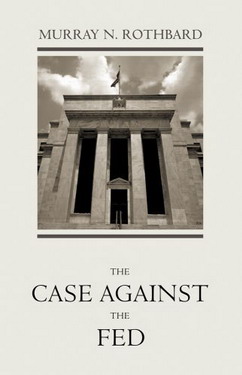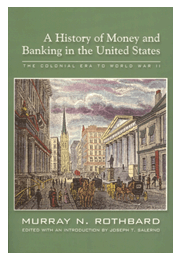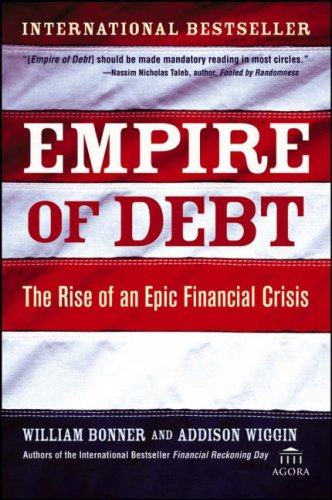
The Case Against the Fed
By Murray N. Rothbard
Ludwig von Mises Institute 2007
158 pages.
In The Decline of the West, Oswald Spengler wrote, “With money-traffic there appears between producer and consumer, as though between two separate worlds, the third party, the middleman, whose thought is dominated a priori by the business side of life. He elevates mediation to a monopoly and thereafter to economic primacy, and forces the other two to be ‘in form’ in his interest … He who commands this mode of thinking is the master of money.”
And no, Spengler was not referring to the Fed. But he very well could have been, for the Fed certainly fits the definition of a monopolistic middleman, who is the master of money. Which is the subject of Murray Rothbard’s book – The Case Against the Fed.
Like many books, The Case Against the Fed starts out with an introduction. But that’s where the similarity ends. For Rothbard’s introduction is a real humdinger. He gets right to his thesis, which is that the Fed is super-secretive, accountable to no one, has no budget, and is subject to no audit. And whenever anyone broaches changing this situation, the “standard reply of the Fed and its partisans is that any such measures, however marginal, would encroach on the Fed’s ‘independence from politics,’ which is invoked as a kind of self-evident absolute.”
In other words, only by means of absolute power and no accountability can the Fed wage its holy war “against inflation.” According to the Fed’s line of reasoning, the public is responsible for inflating the money supply. Which means the Fed is all that stands between the public and the temptation of inflation. In Rothbard’s opinion, “this mythology is the very reverse of the truth.”
Rothbard’s analysis and explanation of the real truth is wonderfully wrought. “If,” says Rothbard, “chronic inflation is caused by the continuing creation of new money, and if [the Central Banking System] is the sole monopoly source and creator of all money, who then is responsible for the blight of inflation?” The answer of course is “the Fed itself.”
This fact, according to Rothbard, explains why the Fed requires secrecy. “If the public knew what was going on,” it would know that the Fed is “itself the heart and cause of the problem.”
After this blistering opening, Rothbard moves on to discuss how money and banking developed. This discussion segues naturally into the ‘optimum amount of money.’ And as Rothbard demonstrates, “any quantity of money in society is ‘optimal.’” Increasing the supply of money in a society is unnecessary and not beneficial. Any increase that occurs is purely and simply inflation, which, in Rothbard’s opinion, is tantamount to counterfeiting.
Counterfeiting increases the money supply, which simultaneously pushes up the cost of goods and services and decreases the buying power of money. The other thing counterfeiting does – and this is an important point – is put more money into the “hands of the counterfeiters.” In other words, the people printing the counterfeit money get richer.
Rothbard points out that historically, there “have been two kinds of legalized counterfeiting.” The first is government printed paper money. The second is “fractional-reserve banking.” And Rothbard’s explanation of fractional-reserve banking is one of the best around. For it is simple and clear, eschewing technical jargon and convoluted models.
From there, Rothbard moves on to Central Banking, providing a brief history of how and where the concept came from. Modern Central Banking came into existence with the Peel Act of 1844, which gave the Bank of England an “absolute monopoly on the issue of all bank notes in England.” Rothbard illustrates how the Central Bank increases its reserves and those of its cartel members – by buying assets which are paid for by money pulled out of the air. This fiat money expands many times, making all the banks rich.
As the reader makes his way through Rothbard’s explanation, he is torn between admiration and shock. On the one hand, such audacity has to be admired. What a simple and effective way to get rich – by making something (money) out of nothing. On the other hand, it is shocking that such trickery is condoned.
Rothbard then proceeds to relate how the Central Bank concept came into being in America. The primary factor – says Rothbard – was Wall Street bankers, who became disgruntled with the National Banking System. Essentially, the National Banking System “was not centralized enough.” Which meant that the money supply “couldn’t be increased fast enough to suit the banks.”
The Morgan and Rockefeller groups began manipulating the situation politically, and – eventually – the Federal Reserve System came into being “at the plush Jekyll Island retreat.” The year was 1911. In 1913, the Federal Reserve Act was passed. The big bankers got their way. They had a “lender of last resort,” which was code for a Sugar Daddy who would allow them to inflate the money supply. In effect, the Morgan banking group was now running the monetary system of the U.S. Later, as a result of the New Deal, the Rockefellers took over, according to Rothbard.
In the final section of The Case Against the Fed, Rothbard describes how the Federal Reserve System methodically pyramids “credits and deposits on top of their initial burst of reserves.” And anyone who bothers to read Rothbard’s lucid explanation is forced to conclude that the Fed does as it pleases. And what it pleases to do is inflate the money supply.
Rothbard’s answer to the whole fiasco is simple: “return to gold and to abolish the Federal Reserve, and to do so at one stroke.” All that is lacking is the will to do so.



I read Rothbard’s “The Mystery of Banking” and learned a lot about money and banking. However, the solution is not a government imposed standard of any form of money including gold. The solution is liberty in money creation combined with the liberty to accept or reject a particular money.
When the Federal Reserve inflates, it’s CREDIT that gets created, not money.
Those who even say the phrase “money supply” simply do not know what they’re talking about. For where you have money supply, you must have money demand and a resulting price to rent said money.
What persons mean when they say the “money supply” is the money SUPPLIED, which is a veiled way of saying credit rather than money in circulation, which is mere notes and coins.
Because persons lack knowledge of commerical law, especially economists, persons don’t get banking whatsoever. A banker is a trader whose business consists in buying money and debts by creating other debts.
While the grocer buys food for resale, the banker buys money or debt and sells credit.
A banker creates and issues credits payable on demand and in doing so puts money already in circulation to greater efficiency.
What a banker is NOT is an intermediary between those who wish to lend and those who wish to borrow.
By setting a interest rate (price), the Fed Res interrupts the Law of Prices (demand and supply set the price). This increases the number of customers for credit for the member banks of the Fed Res, customers who would be bid out of markets for credit under natural economics and the Law of Prices.
In doing so, this leads commercial crisis every time, eventually, as far too many persons rent cash on credit expecting a future that never materializes.
All the Fed Res does it help its members get richer faster and longer than in the absence of a central bank.
Money accretion (new notes, coins adding those in circulation) arises from an increase in average withdrawals of cash at ATMs and bank tellers. Simply, the Fed Res bankers order money minted by the U.S. Treasury, paying for the minting expense.
However, when commerical crisis arises and credit collapse, the economy gets left with more notes and coins in circulation than before.
This causes problems for those who saved their money (notes, coins) as fewer goods get made. Everyone pays the price until the next round of credit expansion (inflation).
Due note that inflation NEVER, EVER means a rise in prices or a rise in “the general price level”.
Inflation results in an expansion of credit. It’s a process undertaken by central bankers to let member banks buy money and sell credit contracts.